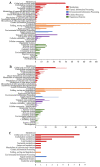Comparative Transcriptome Investigation of Nosema ceranae Infecting Eastern Honey Bee Workers
- PMID: 35323539
- PMCID: PMC8952433
- DOI: 10.3390/insects13030241
Comparative Transcriptome Investigation of Nosema ceranae Infecting Eastern Honey Bee Workers
Abstract
Apis cerana is the original host for Nosema ceranae, a widespread fungal parasite resulting in honey bee nosemosis, which leads to severe losses to the apiculture industry throughout the world. However, knowledge of N. ceranae infecting eastern honey bees is extremely limited. Currently, the mechanism underlying N. ceranae infection is still largely unknown. Based on our previously gained high-quality transcriptome datasets derived from N. ceranae spores (NcCK group), N. ceranae infecting Apis cerana cerana workers at seven days post inoculation (dpi) and 10 dpi (NcT1 and NcT2 groups), comparative transcriptomic investigation was conducted in this work, with a focus on virulence factor-associated differentially expressed genes (DEGs). Microscopic observation showed that the midguts of A. c. cerana workers were effectively infected after inoculation with clean spores of N. ceranae. In total, 1411, 604, and 38 DEGs were identified from NcCK vs. NcT1, NcCK vs. NcT2, and NcT1 vs. NcT2 comparison groups. Venn analysis showed that 10 upregulated genes and nine downregulated ones were shared by the aforementioned comparison groups. The GO category indicated that these DEGs were involved in a series of functional terms relevant to biological process, cellular component, and molecular function such as metabolic process, cell part, and catalytic activity. Additionally, KEGG pathway analysis suggested that the DEGs were engaged in an array of pathways of great importance such as metabolic pathway, glycolysis, and the biosynthesis of secondary metabolites. Furthermore, expression clustering analysis demonstrated that the majority of genes encoding virulence factors such as ricin B lectins and polar tube proteins displayed apparent upregulation, whereas a few virulence factor-associated genes such as hexokinase gene and 6-phosphofructokinase gene presented downregulation during the fungal infection. Finally, the expression trend of 14 DEGs was confirmed by RT-qPCR, validating the reliability of our transcriptome datasets. These results together demonstrated that an overall alteration of the transcriptome of N. ceranae occurred during the infection of A. c. cerana workers, and most of the virulence factor-related genes were induced to activation to promote the fungal invasion. Our findings not only lay a foundation for clarifying the molecular mechanism underlying N. ceranae infection of eastern honey bee workers and microsporidian-host interaction.
Keywords: Apis cerana cerana; Nosema ceranae; differentially expressed gene; honey bee; infection mechanism; microsporidian; transcriptome.
Conflict of interest statement
The authors declare no conflict of interest.
Figures







Similar articles
-
In-depth investigation of microRNA-mediated cross-kingdom regulation between Asian honey bee and microsporidian.Front Microbiol. 2022 Sep 29;13:1003294. doi: 10.3389/fmicb.2022.1003294. eCollection 2022. Front Microbiol. 2022. PMID: 36246221 Free PMC article.
-
Immune Response of Eastern Honeybee Worker to Nosema ceranae Infection Revealed by Transcriptomic Investigation.Insects. 2021 Aug 14;12(8):728. doi: 10.3390/insects12080728. Insects. 2021. PMID: 34442293 Free PMC article.
-
CircRNA-regulated immune responses of asian honey bee workers to microsporidian infection.Front Genet. 2022 Oct 4;13:1013239. doi: 10.3389/fgene.2022.1013239. eCollection 2022. Front Genet. 2022. PMID: 36267412 Free PMC article.
-
Nosema ceranae in European honey bees (Apis mellifera).J Invertebr Pathol. 2010 Jan;103 Suppl 1:S73-9. doi: 10.1016/j.jip.2009.06.017. Epub 2009 Nov 11. J Invertebr Pathol. 2010. PMID: 19909977 Review.
-
[Nosema ceranae (Eukaryota: Fungi: Microsporea)--a new parasite of western honey bee Apis mellifera L].Wiad Parazytol. 2007;53(4):281-4. Wiad Parazytol. 2007. PMID: 18441873 Review. Polish.
Cited by
-
Transcriptome of Nosema ceranae and Upregulated Microsporidia Genes during Its Infection of Western Honey Bee (Apis mellifera).Insects. 2022 Aug 9;13(8):716. doi: 10.3390/insects13080716. Insects. 2022. PMID: 36005340 Free PMC article.
-
Influence of social lifestyles on host-microbe symbioses in the bees.Ecol Evol. 2023 Nov 2;13(11):e10679. doi: 10.1002/ece3.10679. eCollection 2023 Nov. Ecol Evol. 2023. PMID: 37928198 Free PMC article.
-
Extensive influence of microsporidian infection on sucrose solution consumption, antioxidant enzyme activity, cell structure, and lifespan of Asian honeybees.Front Immunol. 2024 Nov 19;15:1404766. doi: 10.3389/fimmu.2024.1404766. eCollection 2024. Front Immunol. 2024. PMID: 39628478 Free PMC article.
-
Distinct virulence of the microsporidian parasite in honey bees competing habitat.Front Cell Infect Microbiol. 2025 Feb 17;15:1524197. doi: 10.3389/fcimb.2025.1524197. eCollection 2025. Front Cell Infect Microbiol. 2025. PMID: 40034393 Free PMC article.
-
Evolutionary Insights into the Length Variation of DNA Damage Response Proteins Across Eukaryotes.Genome Biol Evol. 2025 May 30;17(6):evaf089. doi: 10.1093/gbe/evaf089. Genome Biol Evol. 2025. PMID: 40388363 Free PMC article.
References
-
- Fries I., Feng F., Silva A.D., Slemenda S.B., Pieniazek N.J. Nosema ceranae, n. sp. (Microspora, Nosematidae), morphological and molecular characterization of a microsporidian parasite of the Asian honey bee Apis cerana, (Hymenoptera, Apidae) Eur. J. Protistol. 1996;32:356–365. doi: 10.1016/S0932-4739(96)80059-9. - DOI
-
- Zheng S.B., He J.F., Li Z.G., Gao Z.S., Yu T.T., Xu W.J., Su S.K. Effects of Nosema ceranae on the expression of immune gene and hemolymph sugar levels of Apis cerana bees. Entomol. Knowl. 2017;54:392–399.
Grants and funding
- 32172792/National Natural Science Foundation of China
- xjq201814/Outstanding Scientific Research Manpower Fund of Fujian Agriculture and Forestry University
- CARS-44-KXJ7/the Earmarked Fund for Modern Agro-industry Technology Research System
- Rui Guo/the Master Supervisor Team Fund of Fujian Agriculture and Forestry University
LinkOut - more resources
Full Text Sources

